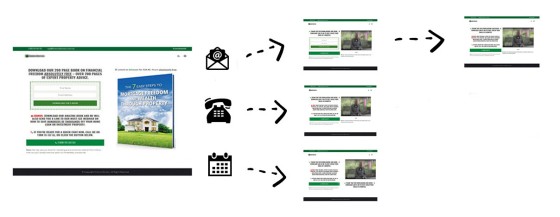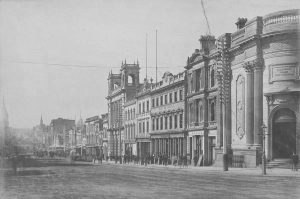Hick's law, or the Hick–Hyman law, describes the time it takes for a person to make a decision as a result of the possible choices. By increasing the number of choices a person may make we will increase the decision time logarithmically. Created by British and American psychologists William Edmund Hick and Ray Hyman, the published paper marked a shift from behavioural psychology to cognitive psychology. The principle is very similar to the The Paradox of Choice, a principle that states eliminating consumer choices can greatly reduce anxiety for shoppers. This article introduces these concepts, and how the psychology has helped shape Belief's core marketing ideology.
The former principle is related to time; that is, the more information you present the longer it takes to reach a conclusion, while the latter study leans towards the 'less is more', or KISS principal: it's easier to make a decision when you have fewer choices to make. It's these two considerations that helped us shape a website experience that converts more than any competing product on the market.
We've designed our mortgage broker website - and all our other websites - to be consistent with the known psychological behaviours we've just introduced, but before we accepted the claims, and without investing our faith into the proven psychology that has withstood the test of time and scrutiny, we tested and analysed conversions over several million page views in the online world (first back in 2012, and then again in 2015 with some variations, and more recently by analysing several million direct funnel pathways that led to conversions). As a result of what we now know to be true, and what we know converts far better than competing designs, we've completely altered the manner in which we render information to a page. In essence we have completely removed any element that doesn't serve a specific purpose, or doesn't make our user experience a more enjoyable journey. As such, we've done something that is diametrically opposed to what you're told will work on a website - we removed the clutter.
This article introduces a concept that is in no way new to our clients. Dating back to our first guide on landing pages in 2002 we said exactly what we're saying today: "your landing pages must be free from distraction, so no headers, sidebars, fancy footers, or any other element that doesn't greasy-up the top-of-funnel entry", and in our 2009 guide, "The Mortgage Magnet" (in no way connected to the very low-performing program on the market), we included over 160-pages introducing design elements that are specific to high-converting mortgage broker websites. More recently we've talked about how some landing pages used in the industry have deliberately introduced business-debilitating roadblocks into landing pages by way of ridiculous quiz style questions, and we've seen others introduce long 'squeeze-style' text that has no place in the industry. Bottom line: the objective of most pages is serviced by way of a single, clear, concise, well-defined, and uninterrupted call-to-action - don't let anything get in the way.
Remember, every page on your website is a type of landing page, so the term 'landing page' as discussed on this page has to be considered in part to encompass all of your website pages, since each of them has the same single conversion-based objective. We're not necessarily talking about the dedicated and purpose-built landing pages you'll see off the tail end of paid promotion.
It's staggering to comprehend why a business will go to costly lengths to get a user onto a landing page, or any page, only to turn them away with offensive questioning or a long sales pitch that convolutes their core message or call-to-action.
Belief has introduced an extremely clean dedicated landing page format that does in a single page what others cannot do in five page views (by way of integrated calendars and conditional redirections), but the landing panel as used on dedicated landing pages (that is, the subscription and lead magnet) is something that shouldn't be hidden away on landing pages only to be found by those that engage in paid promotion. We make a point of repeating ourselves on every single page of this website stating exactly why every single page of your website must provide a conversion opportunity, and why every page requires an integrated calendar (the answer is, of course, that it makes every page on your website as powerful as your dedicated landing pages). A clean page free from confusion draws user attention to the single element the page is ultimately designed to promote.
In an effort to detail why our mortgage broker website was built the way it is, this article, and the associated psychology, was necessary to lean on to validate our data for those that are new to the concept because our methods are somewhat confronting. We've removed two primary elements from each page:
- we've replaced large blocks of text content with a dedicated FAQ block showing relevant information (this applies to post content FAQ and free text FAQ responses), and
- we have completely removed the sidebar on the majority of pages.
It's the website sidebar that is probably the most controversial. These obviously aren't the only areas where we've modified traditional design elements but they are likely the most obvious.
The FAQ module was an easy decision. We introduce more information to the page but do so in a manner that is far less cluttered. If the user launches off into a different direction we start to learn about them from their browsing habits, and as such improve upon their continued experience. The pattern of browsing on a website is itself a funnel that will ultimately guide a user to a page with a conversion opportunity that matches the user interest, and will hopefully filter the user into an escalated funnel program... or get them on the phone.
First, ask yourself why you have a sidebar. The answer is usually because it's what designers used thirty years ago to squeeze more content onto a page, and it's what your web designer probably gave you (since this is how most WordPress themes are created). The clutter it creates is the complete opposite of what we're trying to achieve. Instead, we'll provide a single conversion at the bottom of every single page of your website (that's a full offer, subscription form, and integrated calendar). If we must include additional content on a page we'll usually float it outside of the post content area.
Hick's Law states that the time it takes for a person to make a decision increases with the number of choices, and complexity of choices. Knowing this, how do we grease-up the top-of-funnel entry? We streamline your website by removing distractions, we eliminate unnecessary choices, and we provide a very clear and relevant pathway that we create for each user. In essence, if every single page of our website is a 'type' of landing page, we should endeavour to apply similar high-converting principles on every page, and we certainly shouldn't reserve the features necessary to convert traffic to just certain 'hidden' pages of your site.
The Paradox of Choice
The Paradox of Choice has been a web UX design consideration for as long as we can recall, although the industry is still producing digital assets that are cluttered with irrelevance, and known to limit the effectiveness of website funnel-based conversions. We're asked all the time how our digital systems are able to convert as high as they do, and why they're so much more effective than the pedestrian experiences in the market, and we point to our focus on ROI and funnel engagement. Our design is one that looks good, sure, but it's designed to lock a user into an attention-focused pathway with the funnel or phone call as the primary objective. Does your website have a clearly defined objective, and do the resource on your website actually funnel users into meeting certain funnel endpoints?
Do you present three home loan options to your client, or fifty? Clients will be attracted to brokers because they're able to cut through the noise and centre in on what the client actually needs. This client need is what's giving rise to the machines - comparison websites (often doing a better job than most broker websites because they present solutions... even if flawed). While far from accurate, and rarely taking all the appropriate borrower attributes into consideration, comparison sites simply remove the clutter and provide the user with the illusion of choice. In a sense your website asset performs the same task; a user wants refined actionable solutions.
"Humans have limited capacities for processing information and often choose the path of least effort, even though an alternative path would result in better outcomes. Users often take shortcuts and may appear lazy, but their actions are ways of protecting themselves from information overload and fatigue" - Hoa Loranger.
A website user also has a limited attention span, little patience, and a complete lack of trust.
The Funnel Block
Again, please don't use those crazy quiz-style questions. They were introduced in response to our mid-funnel Venus Report ( a self-assessment report designed to qualify the broker - almost never included on an entry landing page... but often introduced mid-funnel, or occasionally as part of a conditional redirect). The quiz questions are a bottom-of-the-barrel solution introduced by clueless monkeys and really poor lead-generation companies as a poorly designed qualification tool (that doesn't work). The practice violates best interest, industry obligation, common sense, and they seriously compromise your conversions.
Hicks and the Paradox aren't just related to the way information is presented, but how it is required to be actioned.
Naked First Page, Escalated Second Page
If you're going to ask anything of a potential lead, do it once they're in your funnel and you have captured their details. Any keystroke, page-view, question, or anything else in addition to that which is absolutely required, will seriously diminish the value of your paid or organic programs (particularly when advertising on Facebook where we see worst-practice and non-compliance routinely). The escalation of commitment - a term coined by us to defined the funnel pathway - is the basis upon which we're able to elevate or deepen the funnel engagement. The conditional redirections that are an optional part of any subscription form were introduced in part to mitigate the nonsense often peddled on the first entry page. Based on the first page interaction we're able to slowly and appropriately deepen the commitment on subsequent pages after the subscription page has played its part.
Get them into your funnel, then create their conversion pathway.
Powerful Landing Pages
Our fully integrated landing page systems do in one page that takes others up to five (and in the case of the quiz pages, up to fifteen pages)... and if you recognise the value in conversion rate optimisation, the enormous value of our proprietary methods start to become clear. This is true "funnel-hacking" - it's about optimising each of the touch-points a user has with our digital assets in order to escalate their commitment and convert. This 'optimisation' is often the result of adhering to the principles we've introduced - unclutter and focus.
Pictured: Notice the naked landing page. The second, or initial subsequent pages, or the mid-funnel landing pages, are used to escalate the user journey. The focus of your entry landing page is to have a user subscribed to your experience - nothing should interfere with this objective.
As we've made clear in this article, and just about everything shared in our blog, every page on your website is type of landing page because every page is a potential organic entry point. Certainly, if you apply any effort to SEO and then present a page that doesn't actually provide a web funnel into a conversion, you have simply wasted your efforts. Once again, this is the reason we provide facilities for landing panels on every page, and we've recently introduced an even easier-to-use mechanism to return Simple Landing Panels in defined website locations.
Never Use Third Party Landing Page Services
One of the most business-debilitating features you can introduce to your digital programs is third-party landing page services such as Lead Pages, Click Funnels, High Level and others. You don't realise the potential of your marketing - paid or organic - until you vacate these low-performing systems. The use of these services is one of the attributes of a low-performing product. Please steer well clear.
Certainly, if your digital representation has provided you with any experience that doesn't tightly integrate with your website (and this is most of them), or they haven't completely optimised your website to create a real marketing funnel experience, then they've objectively failed you, and they're completely ignoring conversation rate optimisation best practice. Digital marketing is far more than just simple lead generation.
Keep It Simple
Keep your pages clean and as free from as much superfluous text as possible. Keep your call-to-action well defined, prominent, and ensure you include the feature on every page. If you fundamentally alter your understanding of the true purpose a website, what function it is designed to serve, and you then define a clear objective for each page that is served, you'll start to see organic results almost immediately.
Yabber  (our digital marketing and social media management system) takes care of everything we've discussed, and the mortgage broker website we provide clients, or the plugin you include within your existing site, is very tightly integrated with Yabber resources. Since Yabber provides a data-driven experience we're able to identify how very small changes might translate to significant conversion improvements, and you'll often find that it is the removal of content rather than the addition that returns better results.
(our digital marketing and social media management system) takes care of everything we've discussed, and the mortgage broker website we provide clients, or the plugin you include within your existing site, is very tightly integrated with Yabber resources. Since Yabber provides a data-driven experience we're able to identify how very small changes might translate to significant conversion improvements, and you'll often find that it is the removal of content rather than the addition that returns better results.
The mortgage broker website we provide clients attracts more organic visitation, engages more users, and converts far more organic and promoted traffic. Simple as that.









